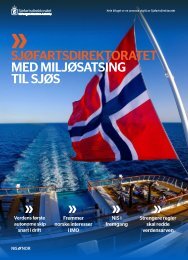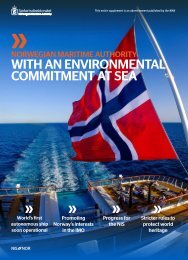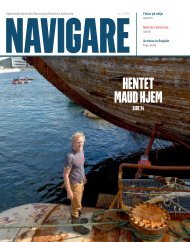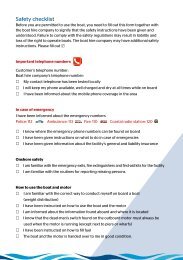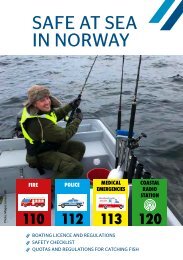Create successful ePaper yourself
Turn your PDF publications into a flip-book with our unique Google optimized e-Paper software.
aktuelt editorial<br />
english translation from page 6<br />
Imposed five sulphur<br />
penalties last year<br />
Since the introduction of the tighter restrictions on sulphur in 2<strong>01</strong>5, the<br />
Norwegian Maritime Authority has imposed a total of 17 penalties for<br />
regulatory violations. The size of the penalties varies from NOK 100 000 to<br />
NOK 600 000, and they have mainly been imposed on foreign ship owners.<br />
In 2<strong>01</strong>8, five cases were finalised. In total, these cases involved penalties<br />
amounting to nearly NOK 2 million.<br />
Kjetil B. Sørensen, Dept. of Regulations and International Agreements, NMA<br />
The first of the cases to be finalised last year<br />
involved a cruise ship registered in the<br />
Bahamas, that had failed to change to lowsulphur<br />
fuel when the vessel was moored in<br />
Geiranger for nearly nine hours in June 2<strong>01</strong>7.<br />
The vessel used fuel with a sulphur content<br />
of 2.52 per cent throughout its stay in<br />
Geiranger. It was equipped with a scrubber<br />
system, but this was not in use in the period<br />
in question.<br />
Geiranger is outside the Emission Control<br />
Area (ECA), and the vessel does not need to<br />
change to fuel with a maximum sulphur<br />
content of 0.10 per cent until it is safely<br />
docked. The owners of the vessel reported the<br />
violation themselves, through their agent.<br />
Shortly after, the Norwegian Maritime<br />
Authority went on board for an unannounced<br />
port state control to obtain verified<br />
information. The shipping line, which is<br />
located in the UK, was fined NOK 300 000.<br />
CAUGHT IN A PORT STATE CONTROL<br />
The next case involved a cargo vessel that<br />
was registered in the Comoros and had been<br />
laid up in Norway for a long period. When<br />
leaving the country in February 2<strong>01</strong>7, the<br />
vessel had an engine breakdown and finally<br />
had to be towed to port. The entire voyage<br />
took place within the ECA. The Norwegian<br />
Maritime Authority boarded the vessel for a<br />
port state control, which also included<br />
collection of a fuel sample.<br />
An analysis of the sample showed that the<br />
fuel had a sulphur content of 0.16 per cent,<br />
clearly above the limit of 0.10 per cent.<br />
Moreover, it was revealed that the vessel had<br />
failed to send out the mandatory AIS signals<br />
during the voyage in question. The shipping<br />
line, which was located in the United Arab<br />
Emirates, was fined NOK 500 000 for these<br />
breaches.<br />
VIOLATING THE REGULATIONS<br />
Moreover, a cargo vessel registered in the Isle<br />
of Man was fined for violation of the sulphur<br />
regulations inside the ECA. The vessel<br />
arrived in Kårstø from Greece in November<br />
2<strong>01</strong>7, having called in at Gent in Belgium on<br />
the way, and the entire voyage through<br />
Norwegian territorial waters was thereby<br />
inside the ECA. The Norwegian Maritime<br />
Authority boarded the vessel and collected a<br />
sample of the fuel in the tanks. The sample<br />
revealed a sulphur content of 0.20 per cent.<br />
The shipping line, which is headquartered in<br />
Greece, was fined a penalty of NOK<br />
300 000. The shipping line appealed the fine,<br />
but the Ministry of Climate and Environment<br />
upheld the decision made by the Norwegian<br />
Maritime Authority.<br />
APPEAL REJECTED<br />
Another case that was finally settled in 2<strong>01</strong>8<br />
involved the penalty that had been imposed<br />
on a Norwegian passenger vessel, which<br />
despite its on-board scrubber system had<br />
been repeatedly registered by the Danish<br />
sulphur sensor on the Storebælt bridge in the<br />
summer of 2<strong>01</strong>6. The Norwegian Maritime<br />
Authority collected material that included log<br />
books from the vessel, and pursuant to the<br />
findings, the Norwegian shipping line was<br />
fined a penalty of NOK 600 000 for the<br />
offence. The shipping line appealed the fine,<br />
but the Ministry of Climate and Environment<br />
upheld the decision made by the Norwegian<br />
Maritime Authority.<br />
INSPECTED AT KÅRSTØ<br />
The last case to be finally settled in 2<strong>01</strong>8 involved<br />
a cargo vessel registered in the Bahamas, which<br />
arrived in Kårstø from Ireland in September 2<strong>01</strong>7.<br />
During an inspection at Kårstø, the sulphur<br />
content of the fuel was measured at 0.139 per cent<br />
with a hand-held device. Laboratory analysis of<br />
the sample showed that the fuel had a sulphur<br />
content of 0.14 per cent. The shipping line, which<br />
is headquartered in Bermuda, was fined a penalty<br />
of NOK 300 000. The shipping line appealed the<br />
fine, but the Ministry of Climate and Environment<br />
upheld the decision made by the Norwegian<br />
Maritime Authority.<br />
56 | <strong>Navigare</strong> 1 - 2<strong>01</strong>9











